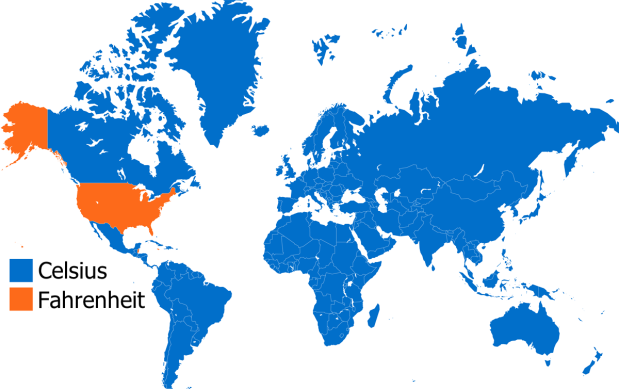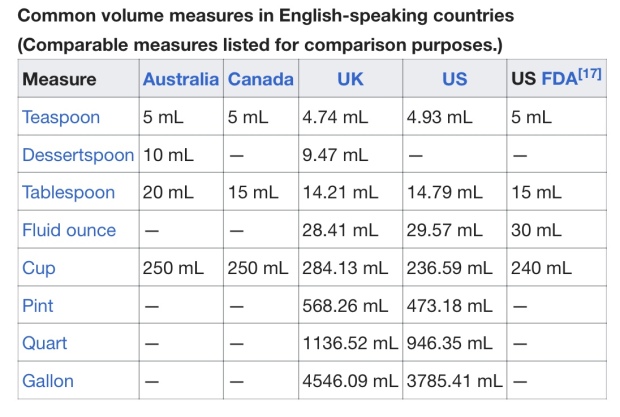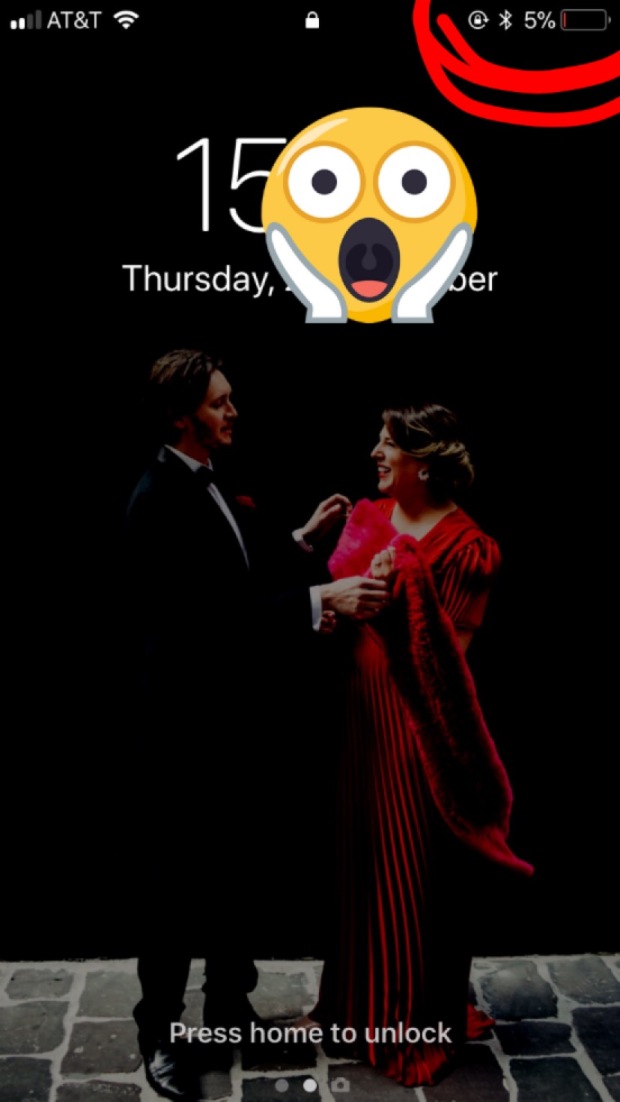What with the events of New York [parts 1.0 and 2.0], turning 40, and realising my ‘trailing spouse’ status, I thought it’d be nice to get a little light-hearted for our next post.
That was the aim, anyway.
But when I actually sat down to write it, I could feel the agitation stirring. I’ve written a lot about the differences between America and Australia. Some are exactly that: just differences, as strange as they might seem at first, like having to drive on the right-hand side of the road. Other noticeable variations, however, seem to be for absolutely no logical reason whatsoever. It’s these ones that annoy me, in much the same way that a small, albeit persistent and incredibly frustrating itch might do.
Gahhhhhh. There it is again. And again. WTAF? Why is this still a thing?
You wanna know what these things are? Read on.
Temperature
Hands up who loves small talk?
*crickets*
Thought so.
Well, as some of you will know all too well, small talk is a (really) big part of being a new person in a new place. As seems to be customary when conversation inevitably dries up and/or moves beyond your ‘gorgeous’ Australian accent, one usually resorts to Weather Talk.
Awkward, right? Definitely for me. There’s one thing that makes it even worse though, and that’s the fact that I can rarely grasp what the other person is saying. The reverse of this is true also.
The other day, for example, I checked the weather forecast for the week (which is still programmed in Celsius in my phone) and got super excited. Ooooh, warm weather! Spring, at last! So I bump into an American friend and say can you believe it’s going to be 26 on Thursday? She looks at me blankly. I immediately click.
Ummm, I mean, it’s going to be warm. Like really warm. But not actually hot.
She’s not getting it.
Of course, 79 (not 26) was the number I was looking for.
Please, people, tell me why the United States still uses Fahrenheit when virtually every other country in the world has switched to Celsius? Celsius, in my mind, is a sensible scale. Zero is the freezing point of water. 100 is the boiling point. Makes sense, right? Incomprehensibly, in the US that means 32 for freezing and 212 for boiling.
* 🤦🏼♀️ *
All this probably makes you wonder why this stupid system was invented in the first place.
Luckily I can help you with that. The Fahrenheit system was invented in the early 18th century by a German scientist, Daniel Gabriel Fahrenheit (you guessed it!). He came up with his scale by picking two random temperatures, setting 0 as the coldest to which he could get a water and salt mix to drop, and (a slightly erroneous) 96 as the average human body temperature. Within that scale he marked the freezing point of water at 32, and the boiling point of water at 212.
Hey presto. The Fahrenheit system was born. It was adopted by the British Royal Society and became the standard scale in the British Empire. As Britain conquered various parts of the globe, they brought the Fahrenheit scale with them, and it gradually became the standard temperature measurement of the 18th and 19th centuries.
…oh sh*t. Sorry everyone. Maybe it is the Brits’ fault after all.
Anyway, fast-forward to the 20th century and most of the world had adopted the Celsius scale (invented in the mid-18th century by Swedish astronomer Anders Celsius). It was adopted into the metric system which, arguably because of its simplicity, spread through the world.
Anyway, at the time, the US decided it would also make sense to get with the more intuitive system, so in 1975 Congress passed the Metric Conversion Act. Yay! Consistency with the rest of the world!
But of course, the Act made the transition voluntary (long live American freedom, or something?) so the public inevitably couldn’t be bothered to learn a new system and the law fizzled out and – ultimately – died. The Metric Board was dismantled in 1982, and no one has tackled it since.

Source: Quora
Go figure.
Measurements
Gosh, where to start. Every day I am bombarded with a unit of measurement that makes no sense to me and renders me speechless.
How many pounds of ham would you like?
How many square feet is your home?
How many miles are you driving?
How many gallons of petrol (gas!) do you need?
How many oz. of tomato sauce (ketchup!) do I want?
And puh-lease… let’s not get started with inches, feet and YARDS.
Seriously, WTF is a yard?!
Anyway, I’ve learned some survival techniques, that’s for sure. Like going for the safe answer. I’ve learnt that the default response to how much of anything I want at the deli is 1 pound. I’ve learnt the speed limits in miles, because I had to sit for my licence (license!) when I arrived. And I’ve learnt that Google is my best friend for making sense of the Imperial world. Finally, I’m making some kind of progress (if you can call it that, the bloody outdated system it is!).
People, let me tell you: this makes life incredibly hard for this little wannabe bake-a-holic. Cooking, once a calm, relaxing and ultimately wholesome activity, is now an anxiety-inducing terror. While Australia keeps it nice and simple (1 teaspoon = 5 ml; 1 dessertspoon = 10ml; 1 tablespoon = 20ml; 1 cup = 250ml), the US has the most random measurements in the history of the industrialised world:

Source: Wikipedia
I mean, what the hell is that?!
It’s clear to me why cooking with Australian cups and spoon measures isn’t really working out:
These may look okay, but they tasted absolutely shocking. Thanks, American measuring conventions.
Date format
When I first arrived in the US, I obviously didn’t yet have my Californian drivers’ licence. This meant – in practice – I was still using my Australian one for proof of age.
I purchased some wine on the 2nd of December (not long after we arrived) and was asked for ID (woo!). I gave it to the staff member. She took the card from me, looked up, and smiled.
‘Happy Birthday!’ she said.
I looked at her, confused. She said it again. I still didn’t get what was going on so I smiled awkwardly and scurried away.
My birthday is the 12th of February. [Thanks to those of you busily etching this into your diaries]. I suddenly realised that my birthday on my Australian licence read DD MM YYYY, but that she’d read it as MM DD YYYY instead.
I mean, I really shouldn’t be complaining, right? I’m a whole 10 months younger in this country!
…but seriously. If I had a dollar for the number of times I’ve had to re-start a form because of date-related stuff-ups, I’d be absolutely mad-rich, that’s for sure!
There are many date formats used in the world, but the US is still the ONLY country that insists on MM DD YYYY. Blimey!

Source: The Guardian
I was really hoping I’d find the answer to ‘why’ but the internet isn’t getting me anywhere at all. The general consensus is that it’s weird. Too right.
What do you think?
Voltage
Moving overseas is an expensive exercise. Sure, we were lucky that our flights and shipping were paid for. But there are many more expenses that one incurs, one of which is replacing every single electrical appliance you have. It really leaves you wondering:
WHY DOES THE US HAVE A DIFFERENT VOLTAGE SYSTEM? Why, why, why?
Why can’t the world just adopt one standard voltage system so people can move everywhere with their goods and simply plug in an adaptor?
Because that would be too easy, Clare.
The whole of Europe, as well as most other continents and countries in the world, uses a voltage system that’s twice that of the USA. It was Nikola Tesla who invented three-phase alternating current (AC) electrical generation (try saying that 10 times fast), and it was also he who preferred a measure of 240 volts for generating those alternating currents. This put him at odds with Thomas Edison, who championed a direct current (DC) system of 110 volts.
I mean, maybe Edison had a point. 110 volts and a DC current that flows only in one direction seems a little safer. AC power was more heavy duty, that’s for sure. But is there really any challenge to be made when you consider how problematic a voltage of 110 can be when, quite literally, the rest of the world is working against you?
When living in Australia, I’d at random times bought things from the US and accidentally blown them up my using my (super powerful, super efficient) Australian power supply in my (super powerful, super efficient) Australian power socket. It was annoying, that’s for sure. But even more annoying is how painfully slow it can be to charge or use an Australian device in the US.
Painfully slow, and expensive. Argh.
I’m not even going to get started as to why countries need to have different plug sockets either.
Seriously. When I moved here, my hair dryer wouldn’t work. Our jaffle maker still doesn’t work. Our phones continue to charge super slowly. Just imagine an angry, haggard , jetlagged Clare with irate children and an equally as wrecked husband trying to get herself cleaned up after a solid 24 hours moving countries. With no working appliances.
Jesus. And so, within only a few hours, it was onto Amazon for a new vacuum cleaner, new hair dryer, new straightener, and the list went on.
Clearly, though, I have a problem with finishing lists .

But for now, dear reader, I leave you to consider this:
For the purpose of celebrating Coco’s MMDD birthday of 7 April (her real birthday is the 4th of July, people), I’m off to bake a cake with an Australian recipe, so the measurements make sense, using my US KitchenAid, and all the while converting Celsius of the Australian recipe to the Fahrenheit of my oven.
Go figure indeed.





Hear! Hear! Silly archaic differences.
And why do some US recipes ask for ‘a stick of butter’ ?
LikeLiked by 1 person
Because they literally sell their butter in sticks, Naina! It’s so different. Although I am quite liking the sticks of butter, I must say. But yeah, makes no sense in Australia where we buy butter in blocks!
LikeLike